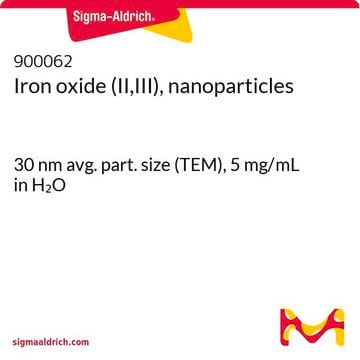The majority (>95%) of the gold nanoparticles are spherical.
Kluczowe dokumenty
742090
Gold nanoparticles
400 nm diameter, stabilized suspension in citrate buffer
Synonim(y):
Au NP, Gold Colloid
Wybierz wielkość
1040,00 zł
Wybierz wielkość
About This Item
1040,00 zł
Polecane produkty
Poziom jakości
Formularz
nanoparticles
suspension
zawiera
Proprietary Surfactant as stabilizer
stężenie
~1.9E+8 particles/mL
średnica
400 nm
PDI
<0.2
temp. przechowywania
2-8°C
ciąg SMILES
[Au]
InChI
1S/Au
Klucz InChI
PCHJSUWPFVWCPO-UHFFFAOYSA-N
Szukasz podobnych produktów? Odwiedź Przewodnik dotyczący porównywania produktów
Powiązane kategorie
Zastosowanie
This material is highly monodisperse (<12% variability in size and shape), and provides significantly improved surface reactivity. Applications include Surface Enhanced Raman Lables, Sensing/Detection, Biological Targeting, Plasmonics and Electronics.
Informacje prawne
Kod klasy składowania
12 - Non Combustible Liquids
Klasa zagrożenia wodnego (WGK)
nwg
Temperatura zapłonu (°F)
Not applicable
Temperatura zapłonu (°C)
Not applicable
Wybierz jedną z najnowszych wersji:
Masz już ten produkt?
Dokumenty związane z niedawno zakupionymi produktami zostały zamieszczone w Bibliotece dokumentów.
Klienci oglądali również te produkty
Produkty
Gold (Au) nanoparticles have tunable optical and electronic properties and are used in a number of applications including photovoltaics, sensors, drug delivery & catalysis.
Nanocząstki złota (Au) mają przestrajalne właściwości optyczne i elektroniczne i są wykorzystywane w wielu zastosowaniach, w tym w fotowoltaice, czujnikach, dostarczaniu leków i katalizie.
Silver nanomaterials have unique physical, chemical, and optical properties that are currently being leveraged for a wide variety of biological applications.
Nanomateriały srebra mają unikalne właściwości fizyczne, chemiczne i optyczne, które są obecnie wykorzystywane w wielu różnych zastosowaniach biologicznych.
-
What is the shape of the gold nanoparticles?
1 answer-
Helpful?
-
-
What is the Department of Transportation shipping information for this product?
1 answer-
Transportation information can be found in Section 14 of the product's (M)SDS.To access the shipping information for this material, use the link on the product detail page for the product.
Helpful?
-
-
Why does my gold nanoparticle solution turn violet when I add salt containing buffer?
1 answer-
Due to repulsive forces arising from the surface charge of gold nanoparticles, an energy barrier must be overcome for individual particles to interact. When no (or small) amounts of electrolytes such as NaCl is present, this energy barrier is too strong for interaction to occur between particles. However, upon addition of NaCl this energy barrier is reduced allowing the gold nanoparticles to interact and aggregate. This aggregation causes a phenomenon called surface-plasmon coupling which changes the adsorption maximum of light to a higher wavelength resulting in a change in color of the solution.
Helpful?
-
-
How do you attach gold nanoparticles to glass?
1 answer-
To view the procedure on how to attach gold nanoparticles to glass please view information in the reference - Journal of Atomic, Molecular, and Optical PhysicsVolume 2012 (2012). Article ID 683830, 6 pagesdoi:10.1155/2012/683830
Helpful?
-
-
Can the Gold nanoparticles be frozen?
1 answer-
No, the Gold nanoparticles should not be frozen. If frozen, the gold nanoparticles will irreversibly aggregate, turning the solution clear.
Helpful?
-
-
How does the storage temperature relate to shipping conditions?
1 answer-
The storage conditions that a Sigma-Aldrich catalog and label recommend for products are deliberately conservative. For many products, long-term storage at low temperatures will increase the time during which they are expected to remain in specification and therefore are labeled accordingly. Where short-term storage, shipping time frame, or exposure to conditions other than those recommended for long-term storage will not affect product quality, Sigma-Aldrich will ship at ambient temperature. The products sensitive to short-term exposure to conditions other than their recommended long-term storage are shipped on wet or dry ice. Ambient temperature shipping helps to control shipping costs for our customers. At any time, our customers can request wet- or dry-ice shipment, but the special handling is at customer expense if our product history indicates that the product is stable for regular shipment.
Helpful?
-
-
Do I need to wash my gold nanoparticles?
1 answer-
For most applications, our gold nanoparticles can be used without any additional washing steps. If you have a sensitive application that requires additional washing the best way to do so is by either centrifugation or filtration.
Helpful?
-
-
My gold nanoparticles settle out of solution upon storage. Is this normal?
1 answer-
Settling of gold nanoparticles on the bottom of the storage flask is completely normal and is especially common for larger sized particles, which settles at greater speed. Settling does not affect the performance of the particles. Prior to use, simply swirl the solution to properly disperse your gold nanoparticles and obtain a homogenous solution.
Helpful?
-
-
How do you attach gold nanoparticles to peptides and peptide conjugates?
1 answer-
To view information on how to attach gold nanoparticles to peptides and peptide conjugates, please view the information in the reference - Rosenthal, S. J. and Wright, D. W. (Eds.). (2005), p. 91-92. NanoBiotechnology Protocols. New Jersey. Humana Press.
Helpful?
-
-
How do you attach gold nanoparticles to oligos?
1 answer-
To attach gold nanoparticles to oligos please view the information in the attached reference - Bioconjug Chem. 2011 Apr 20;22(4):794-807. Epub 2011 Mar 28.
Helpful?
-
Active Filters
Nasz zespół naukowców ma doświadczenie we wszystkich obszarach badań, w tym w naukach przyrodniczych, materiałoznawstwie, syntezie chemicznej, chromatografii, analityce i wielu innych dziedzinach.
Skontaktuj się z zespołem ds. pomocy technicznej


